News
Meet the Design Maven of Home Renovation
Her transformative designs and practical tips redefine home renovation, but what unique insights does Lisa Marie truly bring to the table?

Lisa Marie stands out as the design maven of home renovation, seamlessly blending aesthetics with functionality. Her work transforms ordinary spaces into inviting havens, all while showcasing practical renovation tips. Collaborating with her father, Mike Holmes, they create a unique synergy, using their on-screen chemistry to engage viewers. Lisa effectively manages projects, emphasizing meticulous planning and clear communication among team members, which leads to successful outcomes. Her innovative design solutions incorporate natural light and clever storage while personalizing each project. Anyone curious about her inspiring approach will find even more insights waiting to be uncovered.
Key Takeaways
- Lisa Marie and Mike Holmes combine their expertise, showcasing a unique family dynamic that enhances home renovation projects.
- They emphasize practical design solutions that blend aesthetics with functionality, maximizing space and usability in homes.
- Their approach incorporates natural light and cohesive color palettes, creating inviting and stylish living environments.
- Engaging with their audience, they inspire viewers to tackle their own renovation challenges through relatable tips and innovative strategies.
- Their meticulous project management ensures clear communication and effective planning, leading to successful and timely renovations.
Design Expertise and Skills

Lisa Marie Holmes showcases her design expertise and skills by blending aesthetics with functionality, transforming homes with innovative solutions that address various design challenges.
Her work on *Holmes and Holmes* highlights exceptional design strategies, providing homeowners with practical tips for renovations.
Lisa emphasizes the importance of utilizing natural light to create welcoming spaces and incorporating versatile storage solutions to maximize functionality.
She carefully curates cohesive color palettes, guaranteeing designs are both stylish and practical.
By personalizing each project, Lisa guarantees that every home reflects its owner's unique personality.
Her attention to detail and passion for interior design engage viewers, guiding them through common design dilemmas and inspiring them to embrace their renovation journeys with confidence.
Collaborative Family Dynamics

The collaborative dynamics between Lisa Marie and Mike Holmes bring a unique synergy to their renovations, showcasing how family teamwork can enhance design projects. Their partnership not only highlights their individual strengths but also demonstrates the power of collaboration in achieving stunning transformations.
Viewers appreciate the balance of creativity and practicality that emerges from their joint efforts. They combine design vision with hands-on expertise. Their on-screen chemistry captivates audiences and fosters connection. Family involvement deepens the emotional impact of renovations. Regular viewer engagement builds a loyal community.
Together, they navigate challenges and celebrate successes, making their shared passion for home renovation relatable and inspiring to all who watch.
Effective Project Management

Effective project management is vital in home renovations, ensuring that each phase runs smoothly and meets established timelines.
Lisa Marie Holmes emphasizes meticulous planning and organization in her approach. She highlights the importance of clear communication among team members, which streamlines workflows and prevents misunderstandings.
By establishing realistic deadlines and adhering to them, she guides her projects toward successful completion. Furthermore, Lisa Marie's creative influence fosters innovative solutions to challenges that arise during renovations.
Viewers learn that effective task management and collaboration are essential for any home improvement endeavor. Ultimately, her focus on project management not only enhances the renovation process but also empowers homeowners to tackle their own projects with confidence and clarity.
Innovative Design Solutions

Innovative design solutions play an essential role in transforming spaces and addressing common renovation challenges. Lisa Marie Holmes excels in identifying unique approaches that enhance both aesthetics and functionality. Her keen eye for detail and creativity often result in remarkable transformations that resonate with homeowners.
- Maximizing natural light to create brighter, more inviting spaces
- Incorporating versatile storage solutions for improved organization
- Choosing a cohesive color palette to unify diverse rooms
- Personalizing designs to reflect individual tastes and lifestyles
These strategies not only resolve design dilemmas but also inspire homeowners to reimagine their spaces.
With her passion for interior design, Lisa Marie showcases how innovative solutions can lead to stunning, functional renovations that elevate everyday living.
Audience Engagement Strategies

Engaging audiences through relatable design challenges and practical tips, Lisa Marie Holmes captivates viewers and inspires them to initiate their own renovation journeys.
By sharing her expertise and innovative solutions, she fosters a connection with her audience, making them feel empowered to tackle their home improvement projects.
Lisa's attention to detail and ability to address common design dilemmas resonate with viewers, encouraging dialogue and interaction.
The show's dynamic family collaboration enhances viewer engagement, as fans appreciate the authenticity of their shared experiences.
Through her dedication to education and inspiration, Lisa Marie not only entertains but also equips her audience with the tools necessary to transform their homes, fostering a community of enthusiastic renovators.
Impact on Home Renovation

Through her design expertise and practical approaches, Lisa Marie Holmes greatly influences the home renovation landscape, inspiring homeowners to embrace transformative projects.
Her innovative ideas and eye for detail empower individuals to see potential in their spaces.
- Offers actionable design tips that enhance aesthetics and functionality.
- Encourages homeowners to personalize their renovations, making spaces uniquely theirs.
- Advocates for sustainable practices that benefit both the environment and budgets.
- Builds a community where viewers feel connected and motivated to tackle their own renovations.
Behind the Scenes Insights

Behind the scenes, Lisa Marie Holmes and her team meticulously plan each renovation episode, ensuring every detail aligns with their vision for transformative home designs. They maintain effective communication, coordinating tasks to streamline project execution.
Lisa prioritizes clear timelines and deadlines, educating viewers on the complexities of home renovation management. Her creative influence encourages innovative solutions for design challenges, showcasing her keen eye for detail.
The team collaborates closely, allowing them to adapt quickly to changes and feedback. Lisa's passion for interior design is evident throughout the process, inspiring her team and viewers alike.
This careful orchestration behind the scenes is what makes each episode not only engaging but also a valuable learning experience for aspiring renovators.
How has Christian Yelich’s heritage influenced his design choices in home renovation?
Christian yelich’s heritage insights can be seen in the design choices of his home renovation. Influences from his ancestry are reflected in the use of cultural motifs, traditional materials, and color palettes that pay homage to his roots. His heritage plays a significant role in shaping the aesthetics of his living space.
How Has Vida Guerra’s Love Life Inspired the Home Renovation Designs?
Vida guerra’s romantic journey has influenced home renovation designs through her love for luxurious and elegant spaces. The passion and intensity she brings to her relationships can be seen in the opulent and inviting atmosphere of her home. Vida’s love life has become a source of inspiration for creating dreamy and intimate living spaces.
Conclusion
In the ever-evolving domain of home renovation, Lisa Marie Holmes embodies the essence of a modern-day Athena, blending wisdom with creativity to craft inspiring spaces.
Her ability to connect with audiences while delivering practical design solutions sets her apart as a true visionary.
As she navigates the intricate dance of family dynamics and project management, Lisa continues to empower homeowners, inviting them to commence their own transformative journeys.
With each episode, she leaves an indelible mark on the world of design.
News
Unlock Your Potential with Biohacking Essentials
Discover the art of Biohacking to elevate your life. Tap into cutting-edge techniques for enhanced health and performance.

Did you know nearly 60% of adults struggle with getting enough quality sleep? Good sleep is key for a sharp mind and strong body. That’s where biohacking comes in. It’s a cutting-edge trend aimed at improving yourself. With biohacking, you can boost your brain power, enhance your physical abilities, or just feel more alive. Learn about biohacking principles to reach your best self.
This guide will walk you through biohacking essentials. From its basics to practical advice you can use right away. Embark on a journey of self-improvement and better health by improving your sleep, fine-tuning your diet, trying new technologies, and more. Discover how small shifts can make a big difference in your day-to-day performance!
Key Takeaways
- Biohacking involves changing your chemistry and physiology through self-experimentation.
- Quality sleep is vital for cognitive function, mood regulation, and recovery.
- Regular mindfulness can boost cognitive function and emotional well-being.
- Supplements can support cognitive function and promote overall health.
- Cold exposure enhances metabolism and improves circulation.
- Wearable technology provides valuable data for lifestyle improvements.
- DNA testing offers personalized insights for diet and exercise.
What is Biohacking?
Biohacking is about personal growth through science and self-experimentation. It aims to improve health and well-being by changing biological systems. People, especially those between 35 and 50, use it to look and feel younger.
To optimize health, you can change your diet, use new technologies, and alter your lifestyle. By learning about biohacking, you tailor your journey to better health. Regular exercise, such as strength training, boosts energy in cells and improves heart health and blood sugar levels.
Wearable tech like smartwatches helps measure your biohacking progress. Blood tests give insights into your health, guiding your decisions.
The trend of brain biohacking aims to boost memory and cognitive skills. High-intensity interval training (HIIT) can quickly improve brain health, fostering brain change in just 20 minutes.
Biohacking is growing with DIY biologists, nutrigenomics researchers, and grinders leading the way. Despite unclear regulations, curiosity and innovation drive this community. Biohacking is a way to explore and reach your full potential.
Understanding the Science Behind Biohacking
Biohacking is based on biology, neuroscience, and genetics. It uses detailed data to improve health and performance. Biohackers look into how lifestyle, diet, and advanced tech affect our bodies.
Wearable tech like the Apple Watch and FitBit help us track our health. They monitor sleep, heart rate, and blood sugar. With this info, you can make better choices for your health. For example, InsideTracker offers personalized advice by analyzing up to 43 biomarkers.
- Popular biomarkers targeted by biohackers include vitamin D, cortisol, and LDL cholesterol.
- Methods such as intermittent fasting demonstrate benefits for improving insulin sensitivity and reducing oxidative stress.
- Participating in dietary modifications, such as following a vegan diet, may lower cholesterol while impacting other health markers.
Good sleep is a top priority for biohackers. Wearable tech tracks sleep, helping to improve its quality. Along with sleep, exercise and meditation can boost your health and lifespan.
Some biohacking tools like nootropics may enhance the brain. But, there are safety worries with genetic tweaks using CRISPR. Always use well-supported methods in your biohacking efforts. And seek advice from experts.
Essential Biohacking Techniques for Beginners
Starting your biohacking journey opens up new ways to boost lifestyle changes and performance. Techniques like intermittent fasting can raise your energy and focus. This method focuses on when you eat, helping you adjust your diet.
Sleep optimization is key for better function. Doing foam rolling for ten minutes daily helps keep a good posture for quality sleep. Adding mindfulness activities helps relax and rejuvenate your mind.
Wearable technology is useful for tracking changes in heart rate, sleep, and activity. It helps find what improves your performance. Nootropics are gaining popularity for their potential to enhance brain function.
Here’s a comparison of some beginner biohacking techniques:
| Technique | Benefits | Implementation |
|---|---|---|
| Intermittent Fasting | Enhanced focus, weight management | Limit eating to an 8-hour window daily |
| Sleep Optimization | Better recovery, improved mood | Adopt a consistent sleep schedule |
| Mindfulness Practices | Reduced stress, improved concentration | Incorporate meditation into your daily routine |
| Nootropics | Enhanced cognitive function, increased productivity | Experiment with supplements known for brain health |
As you try different biohacking techniques, aim to learn what best suits your body. Small steps can create big lifestyle and performance improvements over time.
Morning Routine to Boost Biohacking Efforts
Starting your day with a morning routine tailored to biohacking can make a big difference. Begin with hydrating yourself using electrolytes. A simple way is to add a pinch of salt to your water, which aids adrenal health, especially under stress. At least 30 minutes of sunlight exposure is key for your circadian rhythms and mood. Sunlight kickstarts cortisol production, helping reduce sleepiness and cutting down on melatonin.
Practicing mindful movement, like yoga or stretching, rejuvenates your body and gets your mind ready. Cold showers are great for increasing alertness. They work by activating your sympathetic nervous system and boosting your immune system. Experiencing the shock of cold water can also improve blood circulation and raise your energy, which supports your health goals.
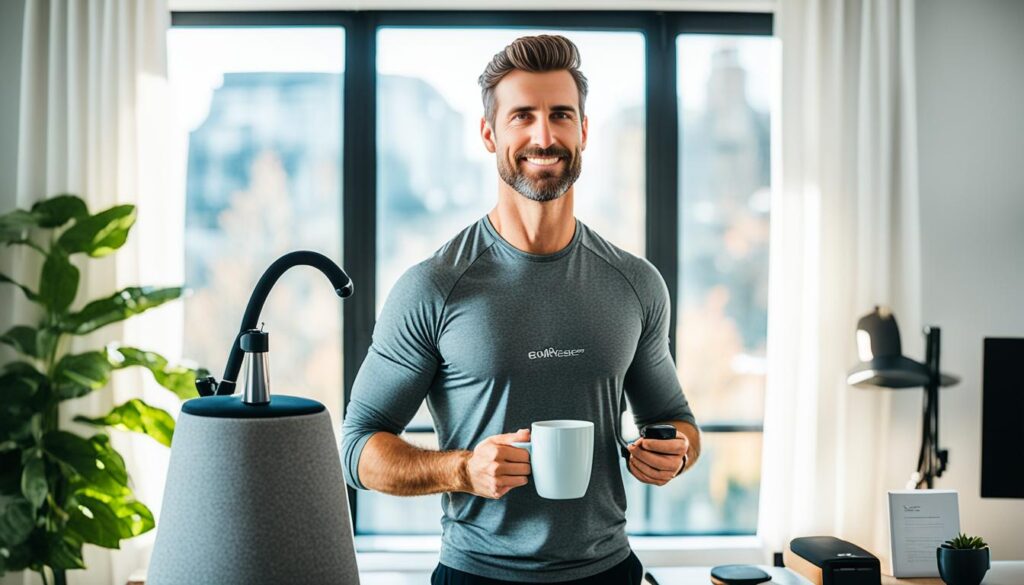
Post-movement, opt for a high-protein breakfast to power up your brain and keep productive habits. Breathwork is a recommended addition to your morning; it’s great for lessening anxiety and boosting mood. Avoid caffeine right after waking up to avoid messing with your cortisol levels. Also, try not to check your phone right away to stay more focused.
| Task | Purpose | Benefits |
|---|---|---|
| Hydration with salt | Support adrenal health | Reduces stress, boosts energy |
| Exposure to sunlight | Set circadian rhythms | Boosts mood, reduces melatonin |
| Mindful movement | Prepare body and mind | Enhances flexibility, mood |
| Cold shower | Increase alertness | Improves circulation, boosts immune response |
| High-protein breakfast | Fuel your brain | Supports cognitive function, energy |
| Breathwork | Enhance mental clarity | Reduces anxiety, improves mood |
Reserving time for setting goals and practicing mindfulness can boost focus all day. These morning biohacking habits lay the groundwork for optimizing your health. They empower you to face your daily tasks with energy and clear thinking.
Nutrition Optimization: Eating for Enhanced Performance
Nutrition optimization is key for boosting your performance through biohacking. Eating whole foods fuels your body and boosts your brain power. It also supports your health. Fruits, vegetables, whole grains, and lean proteins give you vitamins and minerals. These nutrients are vital for high energy levels.
Try different dietary strategies to see what works for you. Comparing carnivore and plant-based diets shows different effects on gut health. Plant-based diets increase certain compounds that can help or hurt your gut, leading to bloating or gas.
- Frequent digestive issues linked to poor gut health include:
- Bloating
- Gas
- Diarrhea
- Constipation
- Individuals suffering from food intolerances often relate this to poor gut health, with a significant percentage affected.
- Symptom occurrences associated with gut health issues include:
- Fatigue
- Sleep disturbances
- Mood swings
- Autoimmune disorders
Eat in line with your body’s clock. It helps your body absorb nutrients better. This method boosts the gains of intermittent fasting. Fasting helps with weight loss and reduces inflammation. Personalizing your diet based on genetics and health indicators fine-tunes your biohacking nutrition.
Use tools like nutrition trackers and food scales to keep an eye on what you eat. Tracking helps you adjust your diet to reach your health targets. Knowing about macros and micros can help optimize your diet for better results.
Biohacking Your Sleep: Techniques for Restful Nights
Good sleep is key to our health and how we perform. Changing small things in your lifestyle and where you sleep can make sleep better. Try going to bed and getting up at the same time every day. Your body’s clock will get used to it. Also, make a calming nighttime routine to tell your body it’s time to relax.
Stay away from screens because their blue light is bad before bedtime. This light can lower your melatonin, making it hard to sleep. Think about using blue light blocking glasses. They help protect your eyes and improve your sleep.
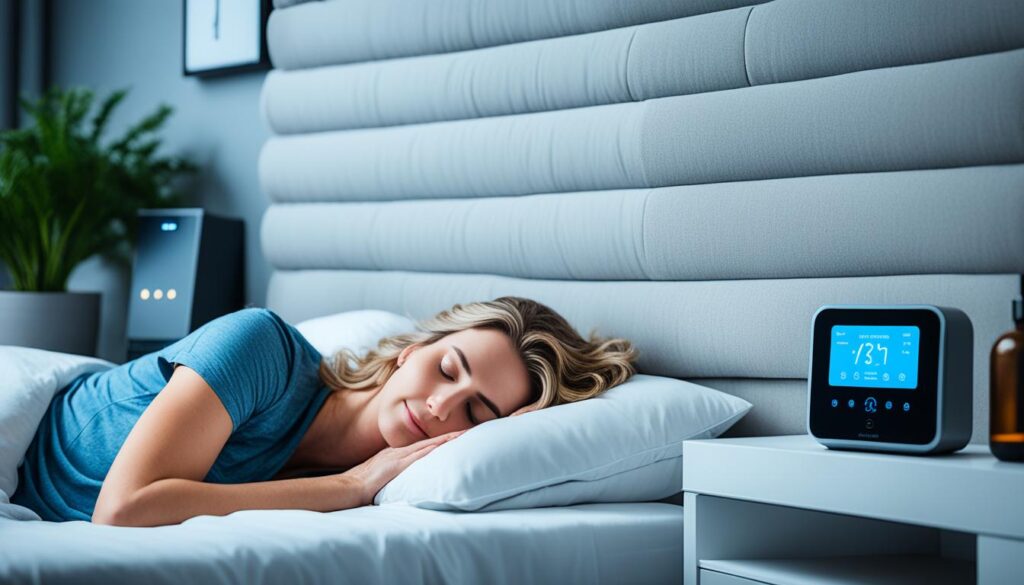
Using smart devices to watch your sleep shows how you sleep and can help change bad habits. Being better at sleeping can make your mind, mood, and body heal better. It’s worth it in the long run.
- Keep your bedroom cool, about 18°C, for better sleep.
- Natural aids like magnesium, valerian root, or melatonin might help you relax and sleep better.
- Exercising in the day helps you sleep at night.
- Lowering stress through mindfulness meditation can make sleeping easier.
Fixing sleep issues might need looking at everything affecting your sleep. Trying out these tips not only makes sleeping easier but also lowers health risks from not sleeping enough. By making sleep a priority, you’ll be more ready to handle what comes your way with better focus and energy.
| Sleep Technique | Description | Benefits |
|---|---|---|
| Consistent Sleep Schedule | Going to bed and waking at the same time daily. | Regulates circadian rhythm, leading to better sleep quality. |
| Blue Light Management | Avoid screens 2-3 hours before bed. | Enhances melatonin production, improving sleep onset. |
| Natural Supplements | Use melatonin, valerian root, or magnesium. | May promote relaxation and improve sleep cycles. |
| Physical Activity | Engage in morning or afternoon exercises. | Improves sleep duration and quality. |
| Mindfulness Meditation | Practice meditation techniques before bed. | Reduces stress and calms the mind for better sleep. |
Adding these tips to your daily life means you can hack your sleep for the better. It leads to a healthier, more active life.
Mindfulness and Meditation in Biohacking
Adding mindfulness to your daily life can give great results in biohacking. Techniques like deep breathing and mindful eating improve emotional health. They make your mind clear and strong. Studies show that too much thinking can block feelings and understanding others. Meditation helps you balance your emotions and thoughts better.
Meditating regularly offers many benefits, such as more creativity and less stress. A calm and focused practice can change your mind and improve your life skills. Some research shows aiming for a ‘flow’ state boosts your abilities. Mindfulness can even change how people around you feel and think.
Creative ideas often come when we’re calm and our mind is off. Using float tanks can help reach these calm states. Programs like 40 Years of Zen change your brain as if you’ve meditated for years. They make you relaxed and happy, fitting well with biohacking.
Mindfulness lets you accept your thoughts and feelings for better emotional health. Trying different meditation types can enhance your life, like better sleep or stress management. Your biohacking journey is about finding how mindfulness and meditation can help you grow.
Technology and Gadgets to Enhance Your Biohacking Journey
In the modern world, biohacking tech is key to better health and brain power. Innovative wearables have changed how we manage personal wellness. These tools are more than cool gadgets; they offer deep insights into our health.
Devices such as the Oura Ring and Whoop Strap 4.0 give detailed body metrics. The Oura Ring monitors health metrics like body temperature, sleep, and heart rate variability. The Whoop Strap 4.0 tracks sleep patterns and skin temp. Both devices help you learn about your body’s reactions and make smart health choices.![]()
- Muse: A wearable EEG headset that encourages mindfulness and meditation.
- Neurosity Crown: Enhances focus through brainwave tracking.
- Flowtime: A device designed for deep meditative states.
- Liftid tDCS Device: A brain stimulation tool that supports concentration.
- Tripp VR: Offers immersive meditation experiences for relaxation.
There are also brainwave entrainment programs and audio tracks for relaxation and meditation. VR apps like Guided Meditation VR and Healium create engaging meditation spaces.
These tools also cover fitness tracking and health stats. It’s easier to spot trends in your daily activities. Continuous glucose monitors offer instant feedback on your diet, helping you adjust it for better health.
Biohacking is growing, with new tech like infrared saunas and smart sleep systems. These devices not only improve your wellness routine but also provide valuable info for long-term betterment.
Cold Exposure: Embracing the Power of Chill
Cold exposure is becoming a popular way to boost your health. It includes cold showers, ice baths, or even cryotherapy. These methods can make your immune system stronger and increase your energy. People who try cold water immersion have more white blood cells. This means they have a stronger defense against illnesses.
Adding cold therapy to your daily life can make you feel happier and think clearer. Studies show it can lessen anxiety and depression. When you immerse yourself in cold water, your body releases endorphins. These are chemicals that make you feel good and calm stress. This practice can also help you sleep better by keeping your sleep cycle regular.
Cold exposure also helps your body make more brown fat. This special fat burns calories to keep you warm, which can help you lose weight. This shows how cold therapy can be good for recovering and managing your weight.
When you expose yourself to cold, your blood flow gets better. This means more oxygen and nutrients can reach your body parts. It’s great for your heart and your overall health. Cold can also make sore muscles feel better after you work out.
Start slowly with cold exposure to make your body tougher. You could try swimming in cold water or cryotherapy. This journey to embrace the cold has many perks for both your body and mind.
| Benefit | Description |
|---|---|
| Immune Support | Cold exposure increases white blood cell counts for a stronger immune response. |
| Mood Enhancement | Reduces anxiety and depression symptoms by releasing endorphins. |
| Circulation Improvement | Enhances oxygen and nutrient delivery while aiding in waste removal. |
| Fat Loss | Stimulates the production of brown adipose tissue (BAT) to burn calories. |
| Muscle Recovery | Promotes reduction of inflammation and soreness post-exercise. |
| Sleep Regulation | Improves sleep patterns and synchronizes internal clocks. |
Conclusion
As you look back on your biohacking journey, you’ll see how big the chance to better yourself is. By using different methods—from changing what you eat to practicing mindfulness—you have what you need to improve your health. This article has given you a strong base to build on for anyone wanting to better their biology and reach their full potential.
Start your biohacking journey with excitement and an open mind. Try out the methods we’ve talked about and pay attention to how your body reacts. Finding what works for you isn’t a one-way road; it’s about trying things out to see what fits. Your personal goals and reasons will help lead the way on this exciting path.
The world of biohacking is always growing, filled with new chances to improve and innovate. Whether your focus is on being stronger physically, getting smarter, or living longer, stay sharp and flexible. Remember, biohacking isn’t just about the end results. It’s about the deep connection between tech and your body as you aim for better health.
FAQ
What is biohacking?
How can I start biohacking as a beginner?
What is the importance of nutrition in biohacking?
How can I improve my sleep quality through biohacking?
What role does mindfulness play in biohacking?
What technologies can I use to enhance my biohacking journey?
What are the benefits of cold exposure in biohacking?
News
Unlock the Glow of Sonoluminescence Explained
Dive into the mystery of sonoluminescence, and discover how sound transforms into an enigmatic glow. Illuminate your curiosity!

Did you know about the bright glow of sonoluminescence? It makes light that shines 2900 times brighter than regular water. This amazing science fact shows how sound turns into light. It happens when bubbles in liquids collapse. As you learn more about how bubbles behave, you find out something incredible. The bubbles get super hot, with the outside reaching about 10,000 K. Meanwhile, the inside hits a mind-blowing 1 million Kelvin.
This article will take you on a journey into the world of sonoluminescence. You’ll learn how it works, how to experiment with it, its history, and what it could be used for in the future. Get ready to light up your knowledge on this fascinating topic!
Key Takeaways
- Sonoluminescence converts sound into light through bubble collapse.
- The phenomenon can produce light up to 2900 times more radiant than plain water.
- Surface temperatures of bubbles in sonoluminescence can reach around 10,000 K.
- Research has shown that core temperatures within bubbles could soar to 1 million Kelvin.
- Understanding the dynamics of bubbles is crucial for exploring sonoluminescence applications.
- Historical discoveries have greatly advanced the field, starting from 1934.
What is Sonoluminescence?
Sonoluminescence is a cool scientific event. It happens when tiny gas bubbles in a liquid light up due to sound waves. Sound waves make these bubbles form and collapse fast. This collapse makes a flash of light with incredible temperatures.
Definition and Overview
Sonoluminescence is when bubbles making light catch our attention. The light shines between 35 and a few hundred picoseconds. It’s very bright, hitting up to 10 megawatts. Inside these bubbles, it gets super hot, even hotter than the sun’s surface. Scientists love studying this to learn how and why it happens.
Historical Background and Discoveries
Sonoluminescence’s study kicked off in the 1930s. It got more attention in the 1990s thanks to work on single-bubble sonoluminescence (SBSL). Seth Putterman and others helped us understand it better. They noticed adding noble gases makes the light even brighter. However, what exactly causes this light show is still a mystery.
How Does Sonoluminescence Work?
Sonoluminescence is a complex process that results in light emission. It showcases how physical principles can create light from normal materials. This happens when certain mechanisms work together.
Mechanisms Behind Light Emission
At the heart of sonoluminescence, tiny bubbles in a liquid shrink quickly, creating extreme conditions. These bubbles are very small, about 0.01 mm. They shrink because of sound waves. When they do, the inside gets very hot, sometimes up to 10,000 kelvins. This heat can ionize gases inside the bubble, possibly making a hot plasma with ionized oxygen and other elements.
The Role of Sound Waves
Sound waves are crucial for enabling sonoluminescence. They form patterns that make bubbles oscillate. A matching frequency between the sound waves and the bubble’s own can cause strong oscillations. The collapsing bubble’s energy focuses into light. This shows how the interaction between bubbles and sound can generate an amazing light show.
| Aspect | Description |
|---|---|
| Temperature | Can reach up to 10,000 kelvins, with estimates suggesting even higher extremes. |
| Wavelength of Emitted Light | Can extend into the ultraviolet spectrum. |
| Bubble Size | Around 0.01 mm, significantly smaller than the sound wave length of approximately 1 cm. |
| Sound Energy Concentration | Believed to peak during the compression phase leading to light emission. |
| Research Implications | Potential applications in nuclear fusion research and other high-energy physics fields. |
| Flash Duration | Lasts only a few tens of trillionths of a second. |
Studying sonoluminescence helps us understand science better. It also opens the door for new inventions using this amazing light.
Creating Sonoluminescence in the Laboratory
An effective lab setup is essential for a sonoluminescence experiment. The right equipment is key to getting bubbles and light emissions. Knowing the right components can lead to a successful setup.
Essential Equipment for Experiments
Your lab should have:
- Piezoelectric transducers for sound waves.
- A sound generator for high frequencies, from 20 kHz to 100 kHz.
- A vessel with degassed water or similar liquid.
- A stable medium for the bubbles that can handle high pressure.
- Devices to check the temperature and pressure for perfect conditions.
Step-by-Step Setup
Here’s how to set up your experiment:
- Start by putting the degassed liquid in your container.
- Put the piezoelectric transducers on the flask walls.
- Link these transducers to your signal generator, setting it to the right frequency.
- Turn on ultrasonic waves to create cavitation bubbles.
- Watch the bubbles. If conditions are right, you’ll see light.
Writing down what you see is crucial for understanding sonoluminescence better.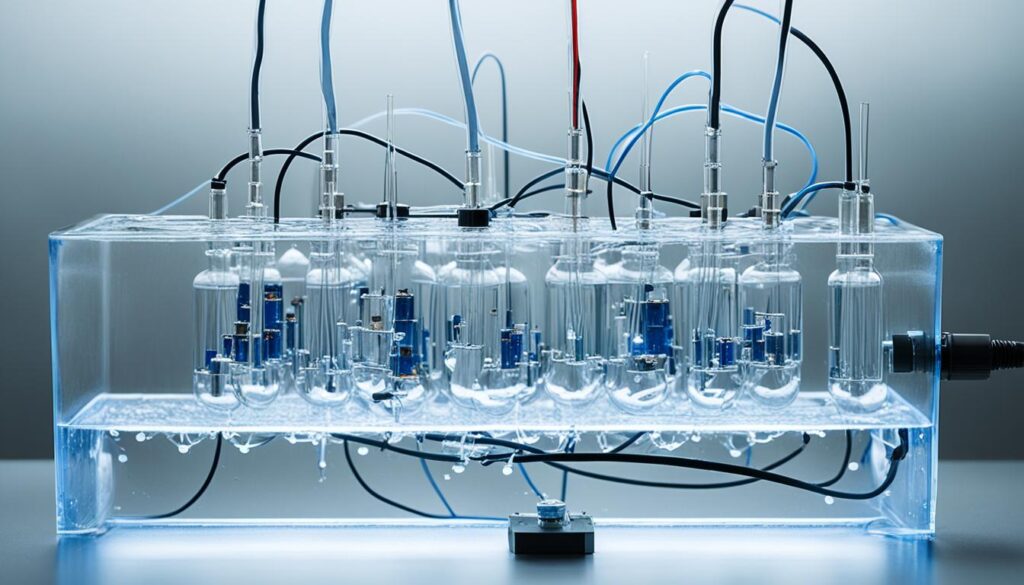
Single-Bubble Sonoluminescence vs. Multi-Bubble Sonoluminescence
In the exciting world of sonoluminescence, two types stand out: single-bubble (SBSL) and multi-bubble (MBSL). Both types shine light differently and have unique implications for experiments. This difference makes each type special in its own way.
Comparison of Light Emission Strength
SBSL usually shines brighter than MBSL. This is because the single bubble doesn’t have to share its energy. It lights up strongly all on its own. On the other hand, MBSL has many bubbles that share the energy. This makes each bubble’s light weaker. Studies from 1990 and 2002 help us understand these differences better, showing how SBSL can be more easily measured.
Research Implications of Each Type
SBSL is very useful for in-depth studies of sonoluminescence. It lets researchers look closely at how bubbles move and share energy. This helps them learn more about how sonoluminescence works. MBSL is also important, especially in real-world uses like cooling and mixing in factories. Studies on cavitation, the forming of bubbles, show us how different conditions affect sonoluminescence. Both types are crucial for learning and for practical use.
Understanding the Bubble Dynamics
The dance of bubble dynamics is key to sonoluminescence. Bubbles oscillate in a liquid during cavitation. This causes big changes in temperature and pressure. It affects light emission and experiment results. Knowing these processes helps improve setups and results.
Temperature and Pressure Changes
When bubbles move, temperatures can spike as they collapse. This compression makes the bubble’s core very hot, around 104 ºK. This is based on the Reyleigh-Plesset equation. The temperature and pressure changes show a complex relationship:
| Bubble Condition | Temperature (ºK) | Pressure (atm) | Light Emission |
|---|---|---|---|
| Normal Conditions | 293 | 1 | Minimal |
| Near Collapse | 104 | Variable | High Intensity |
| Post-Collapse | Variable | High | Duration in Picoseconds |
Bubble Oscillation Effects
The oscillations of bubbles are crucial to sonoluminescence. The sound waves’ frequency and amplitude affect bubble movements. They control the expansion and compression of bubbles. Managing this is key. Too much damping or quick collapse can reduce light. Changes in oscillation impact light strength and duration. This gives researchers key insights for enhancing light emission.
Exploring sonoluminescence, you will see how bubble dynamics play a huge role. This understanding makes the phenomenon even more fascinating.

Current Competing Theories of Sonoluminescence
Sonoluminescence is a captivating light show caused by tiny bubbles in a liquid when sound waves pass through. Among the many theories trying to explain it, Bremsstrahlung radiation and the argon rectification hypothesis are key. They offer different ways to understand this light emission.
Bremsstrahlung Radiation
Bremsstrahlung radiation is a leading theory. It involves charged particles inside the bubble interacting. When electrons move through electric fields in the collapsing bubble, they can emit light. This process gives us a clue into how sonoluminescence happens.
The idea helps us see part of the picture but not everything. It seems the mysteries of sonoluminescence involve more. Things like how the bubble works and the particles inside add to what we know.
Argon Rectification Hypothesis
The argon rectification hypothesis is another interesting idea. It says that adding noble gases like argon changes how light is made when the bubble shrinks. With argon inside, a bubble can reach very high temperatures. This makes more light come out, showing us more about sonoluminescence.
While scientists still debate this theory, it highlights sonoluminescence’s complexity. New experiments are always teaching us more. This helps in areas like quantum computing and medical treatments.
Potential Applications of Sonoluminescence
Sonoluminescence could change the game in medicine and energy production. This amazing event helps us understand physics and has practical uses that could alter medical practices and make energy solutions more sustainable.
Medical Imaging and Drug Delivery
Sonoluminescence can make big changes in medical imaging. Light from sonoluminescent bubbles makes internal structures clearer. This means doctors can see things better. Also, sonoluminescence could revolutionize how medicines are delivered. It can cause medicines to release at specific places by using light, which makes treatments more direct and reduces harmful side effects.
Energy Production and Fusion Research
In energy production, sonoluminescence opens new doors. Scientists study how it might start nuclear fusion reactions. Such reactions could one day power planes and spaceships more cleanly and efficiently, cutting down emissions and saving fuel. It’s an exciting peek into a future with better power systems thanks to sonoluminescence.
| Application Area | Description | Potential Benefits |
|---|---|---|
| Medical Imaging | Utilizing light from sonoluminescent bubbles for enhanced visibility | More accurate internal imaging; improved diagnostics |
| Drug Delivery Systems | Targeted drug release using activated light emissions | Increased treatment efficacy; reduced side effects |
| Energy Production | Harnessing extreme conditions for nuclear fusion insights | Development of sustainable energy solutions; lower emissions |
| Fusion Research | Studying energy dynamics from collapsing bubbles | Potential for revolutionary power systems; enhanced efficiency |
Understanding the Safety Aspects
Engaging with sonoluminescence requires a look at both the phenomenon and safety measures. While generally safe, the lab equipment poses risks. Proper lab safety practices reduce these risks.
Is Sonoluminescence Safe for Humans?
The sonoluminescence process is not a threat to human health. But, lab settings can expose people to high temperatures and pressures. Knowing the risks, like bubble temperature spikes up to 17,000 K, keeps the lab safe.
Handling Equipment Properly
In sonoluminescence research, handling equipment safely is key. Following strict research protocols minimizes risks. Essential lab safety tips include:
- Always wear appropriate personal protective equipment like gloves and goggles when working with hazardous materials.
- Regularly calibrate high-frequency generators to ensure accurate operation.
- Monitor environmental conditions consistently to avoid unanticipated temperature fluctuations.
- Maintain cleanliness and free from contamination in fluid samples.
- Foster an understanding of the equipment to prevent accidents and ensure a productive research environment.
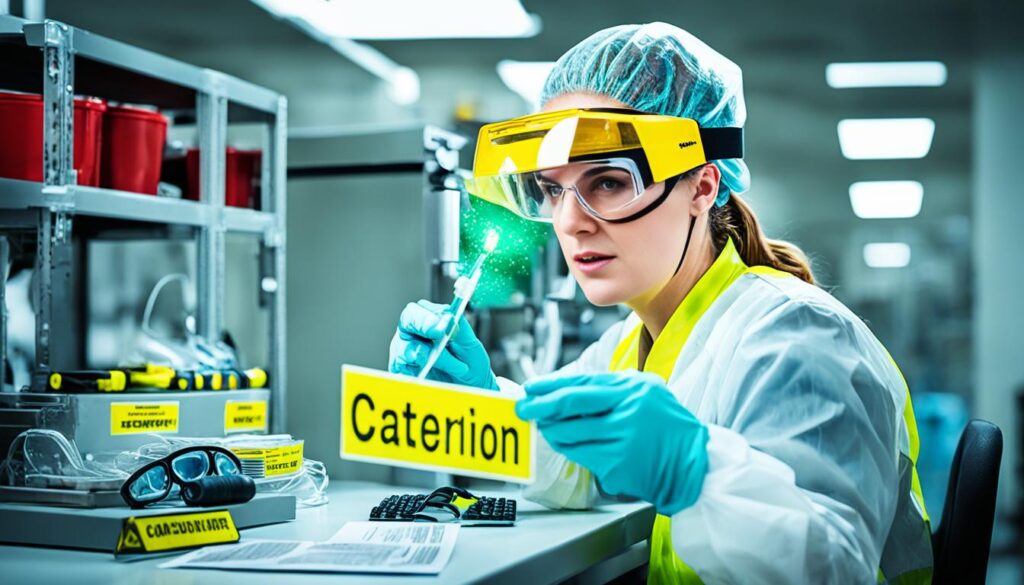
| Safety Measure | Description |
|---|---|
| Personal Protective Equipment | Utilize gloves, goggles, and lab coats to ensure safety during experiments. |
| Calibration of Equipment | Regular calibration of generators is necessary to prevent malfunction. |
| Environmental Monitoring | Consistently monitor conditions to maintain optimal and safe temperatures. |
| Sample Integrity | Keep fluid samples uncontaminated to mitigate unsafe reactions. |
| Training and Protocols | Implement thorough training for all personnel on proper lab safety and equipment handling. |
Recent Research Trends in Sonoluminescence
Research in sonoluminescence has grown a lot, showing new experimental methods and big findings. This trend shows the strong effort to understand this fascinating phenomenon better. Using current methods, scientists are getting closer to knowing more about sonoluminescence. They focus on how bubbles behave and what is needed for the best light to shine.
Innovations in Experimental Techniques
Experimental innovation has greatly influenced recent studies of sonoluminescence. New imaging technologies and better optical cavity designs have been developed. These have allowed scientists to see bubble behavior more clearly. Thanks to these improvements, they can now study the temperature and pressure changes inside bubbles better. This is crucial for knowing how light patterns appear.
Notable Studies and Findings
Latest research highlights the power of sonoluminescence UV light to kill bacteria. This is especially useful in medical areas like activating drugs with light. Studies using sonar with high-intensity focused ultrasound (HIFU) show how changing cavitation thresholds can improve sonoluminescence. Using noble gases like xenon in bubbles also shows how gas type affects light intensity.

Conclusion
Sonoluminescence is a fascinating mix of physics and chemistry. It shows how sound turns into light within bubbles. This process was first seen in the 1930s. By the 1980s, more studies took off. It has caught scientists’ attention due to its complexity and possible uses.
Despite much progress, we still have much to learn about how it works. Researchers continue to work on making reliable single-bubble sonoluminescence. They also create models that mimic real-life situations better. Places like the University of Northern Colorado are leading the way with new experiments.
These studies have shown that sonoluminescence can achieve very high temperatures and pressures. This could lead to big breakthroughs in science and tech.
The future of sonoluminescence research is full of potential. With ongoing support and interest, we might discover more about how it works. This could improve our knowledge and increase its uses. As we keep exploring, both current and future scientists will find new aspects to uncover.FAQ
What is sonoluminescence?
How does sonoluminescence work?
What equipment is needed to create sonoluminescence in a laboratory?
What is the difference between single-bubble sonoluminescence (SBSL) and multi-bubble sonoluminescence (MBSL)?
What are the safety considerations when working with sonoluminescent setups?
What are some potential applications of sonoluminescence?
What current theories explain the light emission in sonoluminescence?
How does bubble dynamics impact sonoluminescence?
What recent research trends are emerging in sonoluminescence studies?
News
Unlock Quorum Sensing Secrets – Explore Now!
Dive into the world of quorum sensing and unlock the mysteries of microbial communication. Explore this fascinating phenomenon today!
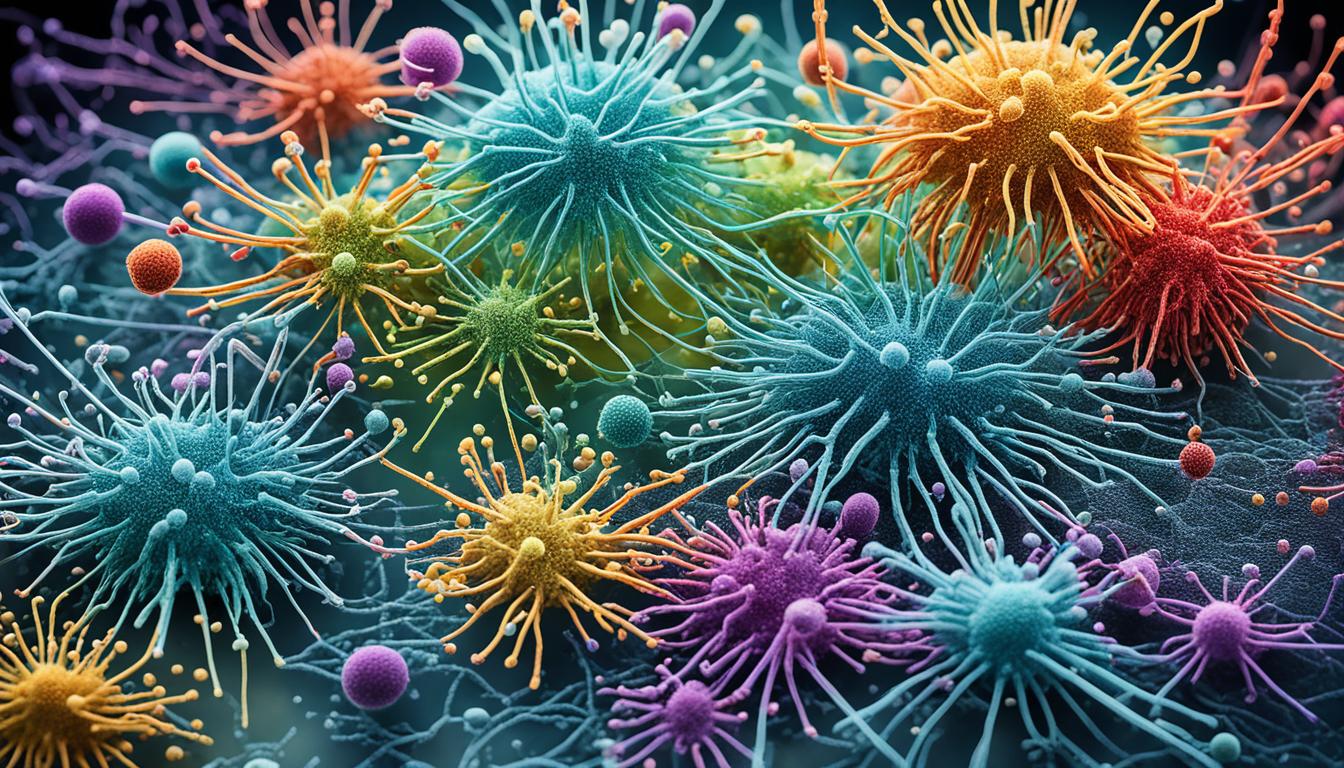
Did you know that Pseudomonas aeruginosa is a common germ in water pipes and sinks? It’s been the focus of 33 studies on quorum sensing between 1970 and 2002. This communication system lets bacteria work together based on how many are present. It shows us how microbes talk and influence their world and ours.
Join us as we delve into the way bacteria communicate. We’ll look at the chemical messages they use and what this means for crops and disease control. By the end, you’ll see how microbes are key players in our environment and health.
Key Takeaways
- Quorum sensing is crucial for coordinating bacterial activities based on population density.
- Pseudomonas aeruginosa has been extensively studied for its quorum sensing mechanisms.
- Key chemicals such as acyl-homoserine lactones are vital for bacterial communication.
- Quorum sensing influences how bacteria behave, including their ability to cause disease.
- Understanding quorum sensing can lead to innovative applications in agriculture.
Understanding Quorum Sensing in Microbial Communication
Quorum sensing is a key part of how bacteria talk to each other. They use this system to coordinate actions based on how many of them are there. By sending out and picking up signals, bacteria can sense their environment and change their behavior. This helps them survive and thrive as a species.
Many scientists are digging into quorum sensing. So far, they’ve found over 12,000 studies on this topic on PubMed. We’ve learned that different bacteria use different signals. For example, certain bacteria in the ocean communicate with molecules called N-acyl homoserine lactones (AHLs). Species like Pseudomonas, Vibrio, and Roseobacter are known for this. Vibrio bacteria even have complex systems to make sure the message gets across correctly.
Research by Tanet et al. found something interesting about the Photobacterium phosphoreum ANT-2200 strain. It glows brighter when there are fewer bacteria around. This shows how important the number of bacteria is in their communication. Studies by Muras et al. found fewer quorum sensing bacteria deep in the ocean, at 2000 meters, compared to shallower waters.
Pseudomonas aeruginosa is another bacteria that uses quorum sensing well. It’s really good at making biofilms, sticky groups of bacteria. This bacteria uses different signaling paths to control over 300 genes. These genes help with harmfulness and keeping the biofilm strong. By working together, these bacteria can survive tough situations.
Learning about quorum sensing lets us understand how bacteria work together and adapt. This research is important for knowing more about nature and how it affects us. The more we learn, the more we see how it impacts both the environment and our health.
How Quorum Sensing Influences Bacterial Behavior
Bacteria are highly adaptable because of a process called quorum sensing. This process lets bacterial colonies act together based on how many of them are present. They respond to certain molecules when there are enough bacteria around. For example, Vibrio cholerae uses quorum sensing to up its virulence during cholera outbreaks. This affects health worldwide.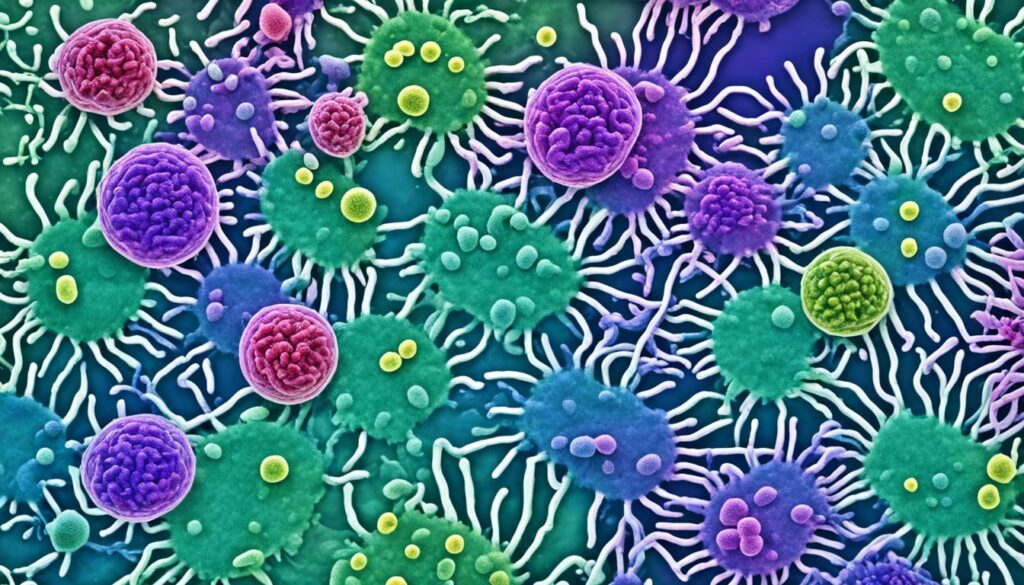
Quorum sensing is key for how bacteria interact with each other. Through it, bacteria can either compete or collaborate. For instance, Bacillus spores can mess with the Agr quorum sensing system of Staphylococcus aureus. This stops S. aureus from spreading. Some bacteria combine forces to become more harmful, like Burkholderia cepacia and Pseudomonas aeruginosa in cystic fibrosis patients.
Quorum sensing plays a part in many bacterial functions:
- Sporulation
- Bioluminescence
- Virulence factor secretion
- Biofilm formation
- Antibiotic production
Take the biofilms made by Porphyromonas gingivalis and Streptococcus gordonii as an example. Their teamwork through quorum sensing can make periodontitis worse. This shows how deep the impact of quorum sensing is on diseases.
New studies are finding ways to target these signaling pathways for treatment. Changing quorum sensing can stop bad bacterial behaviors, like biofilm creation in V. cholerae. Learning about bacteria through quorum sensing gives us new understanding. It helps in both studying microbes and developing medical treatments.
| Bacterial Species | Key Behavior | Impact |
|---|---|---|
| Vibrio cholerae | Virulence Factor Production | Global cholera deaths |
| Pseudomonas aeruginosa | Biofilm Formation | Increased chronic infections |
| Burkholderia cepacia | Co-infection with P. aeruginosa | Severe lung infections in cystic fibrosis |
| Staphylococcus aureus | Quorum Sensing Regulation | Hospital-related infections |
Key Chemicals in Quorum Sensing
Acyl homoserine lactones (AHLs) are at the heart of quorum sensing. These signaling molecules are key in bacterial communication. This is especially true for Gram-negative species like Pseudomonas and Vibrio.
The smarts of these chemicals let bacteria work together based on how many are present. This teamwork ensures they react well to changes around them.
AHLs impact many important bacterial activities. They help form biofilms, which matter a lot for bacterial strength and how well they fight antibiotics. A study in The Lancet (2001) showed bacteria in biofilms can resist antibiotics much more, up to 135-138 times more.
This understanding could lead to new ways to fight bacteria that don’t respond to drugs.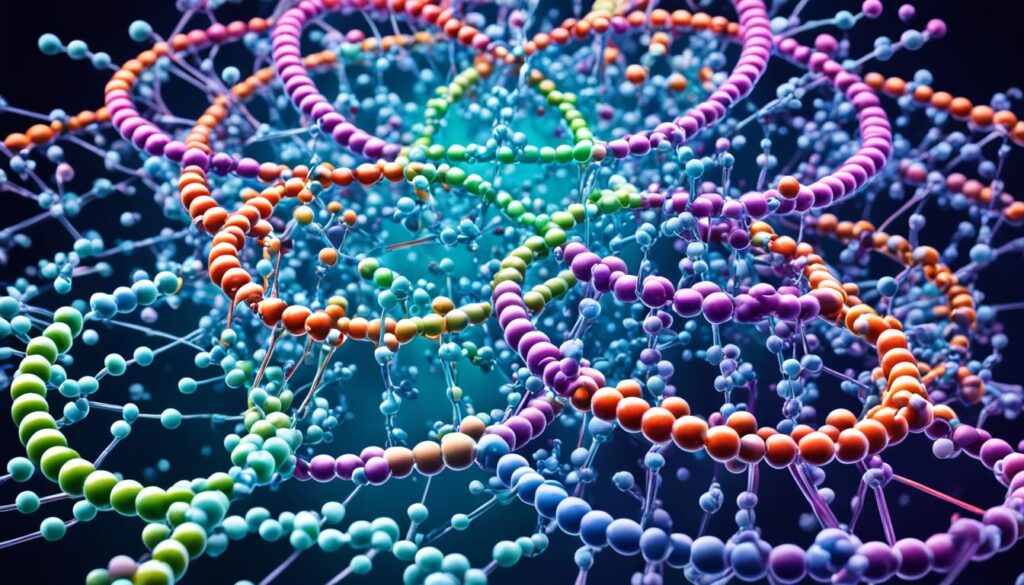
Research into quorum sensing chemicals is a hot topic. It looks for ways to battle disease-causing bacteria. One study found very high death rates from infections with Nosocomial Pseudomonas putida.
This study also saw a scary 91-95% jump in resistance to a major antibiotic class. This info is from Kim SE et al., 2012.
Diving into the world of these chemicals, remember their big impact on microbes. Knowing how AHLs and similar molecules work gives us clues. We can use them to fight back against tough bacteria.
Quorum Sensing and Plant-Microbe Interactions
Plants talk to microbes in the soil in cool ways. They use special signals to make friends with these tiny organisms. This teamwork helps plants get food from the soil and fight off bad germs.
Communication Strategies between Plants and Microbes
Plants and microbes chat using a bunch of signals. One key player in this chat is acyl-homoserine lactones (AHLs). These molecules help them understand each other better. A study in 2012 found that a specific AHL can make mung beans grow roots faster.
Also, how stable these AHL signals are can depend on the plant. This shows how plants can change the way microbes act around them.
The Role of Acyl-Homoserine Lactones
Acyl-homoserine lactones are super important in bacterial group chats, known as quorum sensing. A 2016 study found that plants can make compounds that mimic these bacterial signals. This discovery opens up new ways to use these signals to make crops stronger and more productive.
Scientists keep studying plant and microbe talks. They’re learning how these conversations can help us grow better crops.
| Year | Study Focus | Key Findings |
|---|---|---|
| 2022 | AHL-mediated quorum sensing | Regulates bacterial substance and energy metabolism |
| 2016 | Signal-response systems | Quorum sensing in gram-negative bacteria discussed |
| 2013 | Production of AHL by gram-positive bacteria | Isolated from marine water; microbial signaling insights |
| 2021 | Biofilm patterns in bacteria | Comparative study on gram-positive and gram-negative |
| 2017 | N-acyl homoserine lactones in marine Actinobacteria | Produced by Salinispora arenicola and Salinispora pacifica |
| 2015 | Triazole-containing N-acyl homoserine lactones | Target quorum sensing in Pseudomonas aeruginosa |
| 2003 | Pseudomonas aeruginosa quorum-sensing regulons | Impacts of growth phase and environment analyzed |
| 2018 | Prevalence of autoinducer-2 systems | Effects on thermophiles studied |
| 2020 | Transition state analogs and quorum sensing | Disruptive effects noted |
| 2012 | N-3-oxo-decanoyl-L-homoserine-lactone | Activates root formation in mung bean plants |
| 2005 | Plant-dependent stability of AHL | Key mediator in bacterial quorum sensing |
| 2019 | Quorum sensing inhibitors | Promising antipathogens in biotechnological applications |
| 2013 | Plant-derived natural products | Sources of anti-quorum sensing compounds identified |
The Mechanisms of Quorum Sensing in Pathogenic Bacteria
Pseudomonas aeruginosa shows how pathogenic bacteria use quorum sensing. This bacterium uses quorum sensing to boost its virulence. This lets it survive in many places and be harmful to people, especially those with weakened immune systems.
Quorum Sensing in Pseudomonas aeruginosa
The quorum sensing system of Pseudomonas aeruginosa involves 250 genes. These genes help control 69 proteins linked to its harmful effects. Around 40% of its genetic activity is governed by this system. This control is key for coordinating group behaviors and launching attacks efficiently.
Implications for Human Health
Knowing how Pseudomonas aeruginosa uses quorum sensing is vital for health safety. This system triggers harmful responses, contributing to serious infections. These include ventilator-associated pneumonia, which makes up 20% of such cases. Finding out about these mechanisms can lead to new ways to block the bacteria’s signals. This could help protect people at risk.
Innovative Research in Quorum Sensing Applications
Quorum sensing research is making big strides in microbial technology and synthetic biology. Scientists are finding ways to use microbes’ natural talk to do new things. This could help the environment and lead to sustainable methods.
Some bacteria can be tweaked to talk better to each other. This is key in places like wastewater plants. Better communication means better waste breakdown and more useful byproducts.
New tech mixes quorum sensing with devices that make energy and clean water. This turns waste problems into energy sources. It’s a smart use of microbe tech.
By changing bacteria, we can make plants stronger against diseases. This leads to better crops and more food. It’s a big win for agriculture and sustainability.
Quorum sensing could also help beat superbugs without using common antibiotics. This is key as more bugs resist our drugs. It’s a new way to fight disease.
To wrap up, quorum sensing, microbes, and synthetic biology can do amazing things together. They offer new answers to old problems. Studying them could help our planet and us a lot.
Harnessing Quorum Sensing for Agricultural Improvement
Quorum sensing is key for better farming. This method boosts plant health by supporting good microbes and plants to work together. By playing with these connections, scientists can make crops stronger against bugs and sickness.
Studies have shown changing the microbes around roots unlocks new plant genes. This strengthens plants, boosts their growth, and improves how nutritious they are. Having many kinds of plants helps a lot, as it lets tiny microbes work together better.
Having different plants on the ground is very important for soil health. It makes a microbe-rich area around roots which helps plants grow well and stay healthy. Also, using various biostimulants in small amounts can copy this mix, encouraging plants to grow strong.
| Aspect | Effect of Quorum Sensing | Outcome |
|---|---|---|
| Soil Microbiome | Activates dormant genes | Increased resilience and nutrient density |
| Diversity of Plants | Enhances microbial communication | Improved agricultural productivity |
| Ground Cover | Promotes rhizosheath formation | Boosted plant health |
| Biostimulants | Mimics microbial diversity | Stimulates growth and protection |
By building a rich microbe community with smart farming, we boost soil and create lasting farming methods. Quorum sensing is at the heart of this, aiming to better plant health and farm yields.
Future Perspectives on Quorum Sensing Studies
The future of quorum sensing research is very bright. It covers many areas like agriculture, medicine, and helping the environment. New studies are aiming to know more about how microbes talk to each other. This could lead to new ways to stop harmful microbes and make the ecosystem better.
New technology is changing the game in microbiome studies. Tools like CRISPR are opening doors to edit genes in exciting ways. By tweaking how microbes signal to each other, we could change their behavior. This could improve how nutrients move around in nature.
Here are some exciting directions for future research:
- Exploration of Novel Quorum Sensing Signals: We might find new signals microbes use to chat and understand their effects better.
- Integration with Synthetic Biology: By combining quorum sensing with synthetic biology, we could create special microbial communities. These could help the environment in new, sustainable ways.
- Focus on Human Health: Learning about quorum sensing in bad bacteria could lead us to new treatments. This has big possibilities for improving our health.
As we keep exploring how microbes communicate, we’ll see big benefits. These could make farming better and help the planet. With more discoveries on the horizon, quorum sensing research is set to change our world. It’ll give us new insights and tools like never before.
Conclusion
Quorum sensing is a key way bacteria talk to each other. It’s not just for scientists; it’s crucial for everyone to understand. This system is part of a big chunk of bacterial DNA. It affects many bacterial proteins, showing how big its role is in microbial life.
Bad bacteria like Pseudomonas aeruginosa and Staphylococcus aureus use quorum sensing to be harmful. For example, P. aeruginosa controls its harmful traits through specific systems. Blocking these systems can make infections less dangerous. Also, new ways to mess with quorum sensing could help fight bacteria better.
Studying quorum sensing helps us in many ways, from health to farming. It helps us find new ways to solve big problems, like keeping food safe and fighting diseases. We need more research to fully use its benefits. The future of quorum sensing research is exciting and important.
FAQ
What is quorum sensing?
Why is quorum sensing important in microbial communication?
How do bacteria use quorum sensing to behave differently?
What are acyl-homoserine lactones (AHLs) and their role in quorum sensing?
How do plants communicate with soil microbes?
What is the significance of quorum sensing in pathogenic bacteria?
How is synthetic biology related to quorum sensing?
What potential benefits does harnessing quorum sensing hold for agriculture?
What are the future prospects of quorum sensing research?
-

 Home Decor & Design4 months ago
Home Decor & Design4 months agoWall Decor Inspiration: Creative Ideas to Transform Your Space!
-

 Beauty and Personal Care4 months ago
Beauty and Personal Care4 months agoIs Your Moisturizer Sabotaging Your Tan
-

 Beauty and Personal Care4 months ago
Beauty and Personal Care4 months agoEssential Tips for Safe Tanning Practices
-

 Beauty and Personal Care4 months ago
Beauty and Personal Care4 months agoDiscover Youthful Glow With Anti-Aging Tanning Lotions
-

 Beauty and Personal Care4 months ago
Beauty and Personal Care4 months agoUnlocking the Secrets to Tanning Success
-

 Home Decor & Design4 months ago
Home Decor & Design4 months agoEmbrace Your Eclectic Dress Style & Stand Out
-

 Home Decor & Design4 months ago
Home Decor & Design4 months ago10 Budget-Friendly Ways to Create a Cozy Cottagecore Living Room
-

 Home Decor & Design4 months ago
Home Decor & Design4 months agoUnleash Your Space: How to Decorate Eclectic Style











